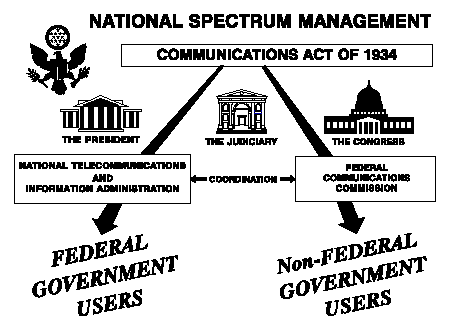In 1906, the year when speech and music were first broadcast using radio, the first international radio conference was held because of the widely recognized need to coordinate and control the use of the spectrum between 500 and 1500 kHz. In the United States, the clamor for regulation resulting from widespread interference caused by unchecked transmission resulted in the Radio Act of 1912. The 1912 Act required the registration of transmitters with the Department of Commerce but did not provide for the control of their frequencies, operating times, and station output powers. Thus, there was no real regulatory power, and the 1912 Act was largely unsuccessful. However, in 1922 U.S. government users of the spectrum banded together under the Secretary of Commerce to form the Interdepartment Radio Advisory Committee (IRAC) to coordinate their use of the spectrum. The Government's use of the spectrum was more easily coordinated than the public's because the IRAC represented all of the federal users, and they found that cooperation was mutually beneficial.
The Radio Act of 1927 established the Federal Radio Commission, and the Communications Act of 1934 ("the Act", 47 U.S.C. ß 51 et seq), established the Federal Communications Commission (FCC). The 1934 Act gave the FCC broad regulatory powers in both wire-line based communications, such as telephone and telegraph systems and radio based communications, limited at the time to broadcasting, long distance single channel voice communications, maritime and aeronautical communications, and experiments that led to radar and television applications. Section 305 of the Act preserves for the President the authority to assign frequencies to all Federal Government owned or operated radio stations. In addition, the President retains the authority to assign frequencies to foreign embassies in the Washington, D.C., area and to regulate the characteristics and permissible uses of the Government's radio equipment. The IRAC, whose existence and actions were affirmed by the President in 1927, has continued to advise whoever has been responsible for exercising the Section 305 powers of the President. These powers currently are delegated to the Assistant Secretary of Commerce for Communications and Information who is also the Administrator of the National Telecommunications and Information Administration (NTIA).
As shown above, the use of the electromagnetic spectrum in the United States is managed using a dual organizational structure; NTIA manages the Federal Government's use of the spectrum while the FCC manages all other uses. The Act provides for the functions of developing classes of radio service, allocating frequency bands to the various services, and authorizing frequency use. However, the Act does not mandate specific allocations of bands for exclusive Federal or non-federal use; all such allocations stem from agreements between NTIA and the FCC. In other words, there are no statutory "Federal" or "non-federal" bands.
NTIA and the FCC manage their particular constituents' uses of the spectrum; however, both must keep in mind the overall general interest since 93.1% of the spectrum below 30 GHz is shared, with only 5.5% and 1.4% allocated respectively to the private sector and the Government on exclusive bases.


|
To be contacted for a confidential consultation please E-mail: jmatk@tscm.com
or send a letter via US Mail to:
or call:
URL: http://www.tscm.com/ |